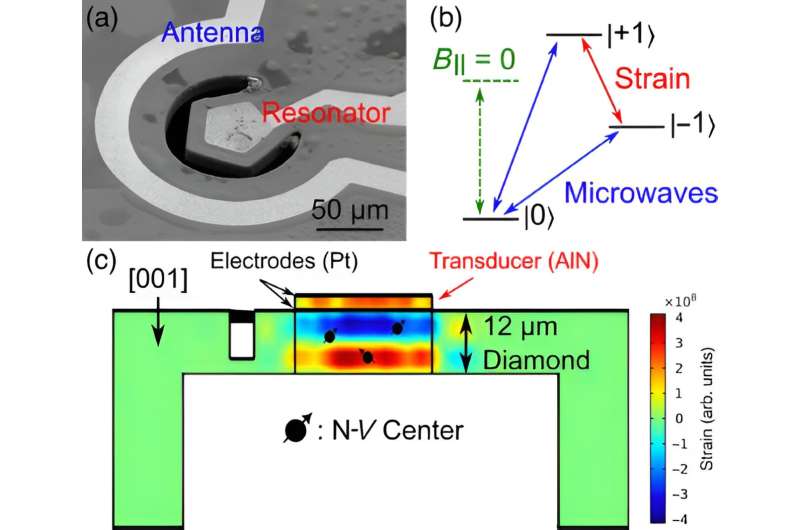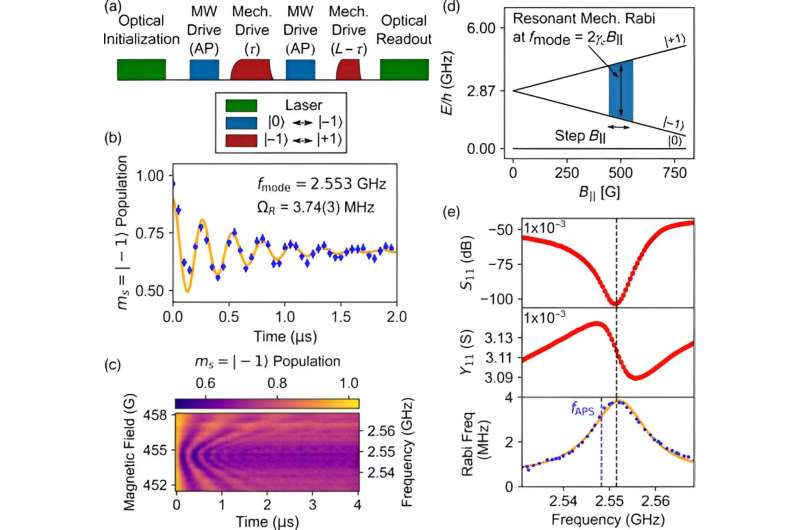This article has been reviewed according to Science X's editorial process and policies. Editors have highlighted the following attributes while ensuring the content's credibility:
fact-checked
peer-reviewed publication
trusted source
proofread
X-ray imagery of vibrating diamond opens avenues for quantum sensing

When it comes to materials for quantum sensors, diamond is the best game in town, says Cornell University professor Gregory Fuchs. Now he and a team of scientists have upped diamond's game by generating exquisite imagery of diamond undergoing microscopic vibrations.
The team, comprising researchers at the U.S. Department of Energy's (DOE) Argonne National Laboratory, Cornell and Purdue University, achieved a two-fold advance for quantum information science.
First, pulsing the diamond with sound waves, they took X-ray images of the diamond's vibrations and measured how much the atoms compressed or expanded depending on the wave frequency.
Second, they connected that atomic strain with another atomic property, spin—a special feature of all atomic matter—and defined the mathematical relationship between the two.
The findings are key for quantum sensing, which draws on special features of atoms to make measurements that are significantly more precise than we're capable of today. Quantum sensors are expected to see widespread use in medicine, navigation and cosmology in the coming decades.
Shake and spin
Scientists use spin to encode quantum information. By determining how spin responds to strain in diamond, the team provided a manual on how to manipulate it: Give the diamond a microshake in this way, and the spin shifts this much. Shake the diamond that way, and the spin shifts that much.
The research, published in Physical Review Applied, is the first time anyone has directly measured the correlation in diamond at gigahertz frequencies (billions of pulses per second).
It is also part of a larger effort in the quantum science community to precisely connect atomic strain and the associated spin in a broad range of materials. For example, researchers at Argonne and the University of Chicago previously measured spin-strain correlations in silicon carbide, another star material that researchers are engineering for quantum applications.
The group's research is supported in part by Q-NEXT, a DOE National Quantum Information Science Research Center led by Argonne.
"We're connecting two sides of an equation—the spin side and the strain side—and directly comparing what's going on in the diamond," said Fuchs, a professor in Cornell's School of Applied and Engineering Physics and a collaborator within Q-NEXT. "It was very satisfying to directly hammer both of them down."
Solving the spin-strain equation
The two sides of the equation were hammered down hundreds of miles apart.
For the spin measurements, scientists at Cornell University in New York measured how spin responded to the sound waves pulsing through the diamond using a one-of-a-kind device developed by researchers at Cornell and Purdue.
For the strain measurements, Cornell graduate student and paper author Anthony D'Addario drove 700 miles to Argonne in Illinois to use the Advanced Photon Source (APS), a DOE Office of Science user facility. The 1-kilometer-circumference machine generates X-rays that allow researchers to see how a material behaves at the atomic and molecular level.
Having generated images of strain in other materials for quantum technologies, it would now do the same for diamond. The team used an X-ray beam jointly operated by the APS and Argonne's Center for Nanoscale Materials, also a DOE Office of Science user facility, to take strobe-light-like pictures of the diamond's atoms as they shook back and forth.
They focused on a particular site within the diamond: an irregularity called a nitrogen vacancy (NV) center, which consists of an atom-sized hole and a neighboring nitrogen atom. Scientists use NV centers as the basis for quantum sensors.

The APS's high-resolution images enabled the team to measure the atoms' movement near the diamond's NV centers to one part in 1,000.
"Being able to use the APS to unambiguously look at or quantify the strain near the NV center as it's being modulated by these beautiful acoustic resonators developed at Purdue and Cornell—that allows us to get the story locally near the NV centers," said Argonne scientist and Q-NEXT collaborator Martin Holt, who is also an author on the paper.
"That's always been the beauty of hard X-rays: being able to look entirely through complex systems and get quantitative answers about what's inside."
With both spin and strain measurements in hand, Fuchs and team related the two in an equation that, satisfyingly, agreed with the theory.
"The most exciting part was in doing the analysis. We ended up finding a new number that related the spin and strain, and it ended up agreeing with some theory and previous measurements," D'Addario said.
Acoustic engineering
Spin can be manipulated in a few ways. The most popular is to use electromagnetic waves. Using acoustic waves is less common.
But it has advantages. For one, acoustic waves can be used to manipulate spin in ways that can't be achieved with electromagnetic fields.
For another, acoustic waves can protect the quantum information encoded in the spin. Quantum information is fragile and falls apart when disturbed by its environment, a process called decoherence. One of the aims of quantum research is to stave off decoherence long enough for the information to be processed successfully.
"It's a little counterintuitive that adding sound to a system makes it better, but it's a bit like turning on a white noise generator to not hear a conversation," Holt said. "You can use the acoustic waves to protect the quantum bit from decoherence. You're shifting what the system is sensitive to in a way that protects it from these other sound processes."
There's also the advantage of miniaturization. Whereas a 1-gigahertz electromagnetic wave is roughly a foot long, a gigahertz acoustic wave is tiny, about the width of a human hair. That small wavelength allows scientists to place multiple similar devices in a small setup and still ensure that their signals won't cross each other.
"If you want there not to be a lot of discussion or interference between neighboring devices, then you can use acoustic-wave devices, which can be very confined," Fuchs said.
Combining these advantages with diamond makes for a superior quantum sensor. As a host for quantum information, diamond enables long information lifetimes, can operate at room temperature and provides reliable measurements.
"I would say most people would agree with me that, for quantum sensors, diamond is king," Fuchs said.
Cross-discipline collaboration was key to the effort.
"Because of the complexity and sensitivity of these systems, there are many different things that can move quantum phenomena around," Holt said.
"Being able to carefully baseline the response to individual pieces requires correlation. That's a multidisciplinary question, and that's something that Q-NEXT is very well-suited to answer. The investment of Q-NEXT in terms of creating in-operation environments for quantum systems in these facilities is really paying off."
More information: Anthony D'Addario et al, Stroboscopic x-ray diffraction microscopy of dynamic strain in diamond thin-film bulk acoustic resonators for quantum control of nitrogen-vacancy centers, Physical Review Applied (2024). DOI: 10.1103/PhysRevApplied.22.024016
Journal information: Physical Review Applied
Provided by Argonne National Laboratory





















